In this Good Practice Note, Dr Luna Panda and Ms. Sagarika Mishra present the interventions of Pragati on strengthening the finger millet ecosystem in Koraput (Odisha, India), and the impact it has on the livelihoods of small and marginal farmers.
THE CONTEXT
Koraput district, in South Odisha, India, is characterized by warm and humid climate with 80% of the total annual rainfall received from the south-west monsoon in the months from June to mid-October. Agriculture is primarily rainfed with kharif (June-September) being the main cropping season. Finger millet is a major staple food crop, second only to paddy, cultivated by the farmers in the rainfed uplands of Koraput district. The area under finger millet (Box 1) accounts for 16% of the total gross cropped area and 28% of the total area under cereal crop cultivation in the district. The tribal communities predominantly cultivate local landraces of finger millet using traditional agronomic practices. Millets are mostly grown in kharif (June-October) in the marginal uplands and hilly regions with little external inputs, either as a sole crop or with different crops like small millets, pulses, legumes and oilseeds under mixed farming systems. The consumption of millets has declined significantly due to greater reliance on rice, especially promoted under the Public Distribution System (PDS) system. Besides, in recent years, there has been a noticeable shift in dietary habits, tastes and preference among younger generations have changed, furthermore processing millets for consumption at home is tedious and time consuming – both of which have led to millets being regarded as a minor food.
|
Box 1: Finger Millet (Eleusine coracana), in Koraput Being a sturdy crop, finger millet is quite resilient to a variety of agro-climatic adversities such as poor soil fertility, long dry spells, and drought conditions. Apart from its resilience to climate hazards, the crop also provides an ecological niche for beneficial organisms, such as predators of insect pests, so that destructive insect pests can be controlled naturally, which in turn means that the crop does not need external plant protection measures. It is also known as a ‘famine crop’, and the seeds can resist storage pests for as long as 10 years, ensuring year-round food supply, even during a period of crop failure. The gruel prepared from finger millet flour is one of the major components of daily diet of the rural communities in Koraput district. Moreover they also prepare local wine and cakes (tampa) with jaggery and millets during festive occasions. The local processing is limited to household level activities, such as de-husking/cleaning and then grinding into flour. Apart from its importance as a nutritious food crop, finger millet contributes greatly to the incomes of rural households. Despite great value associated with this nutri-crop by the local communities, there has been a decline both in area and in production of the crop. The area under finger millet cultivation in the district declined by 55% over three decades, from 144,480 hectares in 1980 to 65,160 ha in 2013. With the implementation of the Odisha Millet Mission Programme, the area under finger millet has increased. In 2020-21, it was observed that the area under Finger Millet had increased to 71,130 ha. Further, due to traditional cultivation practices, the grain yield is as low as 3 to 4 quintals per hectare under the broadcasting method; and even with traditional transplanting methods, yield is only 6 to 8 quintals per hectare. Some of the primary reasons are: use of low-quality seeds, broadcasting method of sowing leading to low plant population, and lack of proper crop management. Farmers prefer to use their ‘own saved’ seeds, indicating the importance attached to seed recycling at the farm or village level. All these factors have adversely affected the millet eco-system resulting in food and nutritional insecurity among rural population, accelerated loss of genetic diversity of millets making the production systems vulnerable to climate change effects. |
After many years of neglect, millets, especially finger millet production, is being promoted by the government under the Odisha Millet Mission Programme through farmers’ incentives for adoption of improved agronomic practices, such as System of Millet Intensification. The government has also announced Minimum Support Prices (MSP) for millets to promote its cultivation. Millet-based enterprises have evolved and flourished with encouragement from the private sector as well as the government.
Pragati (https://pragatikoraput.org/) worked on three fronts, namely production, consumption and marketing of millets; and our good practices from these interventions are discussed below.
GOOD PRACTICES
- System of Millet Intensification (SMI) – An agro-ecological innovation for enhancing productivity and climate change adaptation.
Introduction of SMI
The intensification method with finger millet (SMI) was introduced by Pragati in 2009 along the principles followed in System of Rice Intensification (SRI) with the objective of enhancing production from small farms by depending more on endogenous processes than on external inputs. The practices included seed treatment, raising nursery, transplanting of young seedlings, spacing, mechanized weeding to aerate the soil, and application of organic manures for nutrition and pest management. The substantial increase in yield motivated farmers to adopt the practices more widely and enthused Pragati to scale up the technology to other areas with many more farmers.
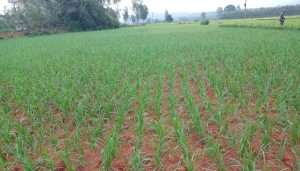 System of Millet Intensification
System of Millet Intensification
Promoting SMI
In order to scale up SMI, Pragati adopted some of the farmer-friendly extension methods such as trainings, exposure visits, field demonstrations, mediated video disseminations, on-field support by community resource persons, farmers’ fairs, crop cutting and field days. The officials of the Department of Agriculture and Farmers’ Empowerment (DoA&FW), Government of Odisha, have been involved in the crop cutting and field days for validation of the results. During farmers’ fairs, successful farmers share their experiences and also interact in groups, which has helped in dissemination of the practices to more and more farmers. Successful farmers are being felicitated so as to encourage the practicing farmers as well as to motivate other farmers to adopt these practices.
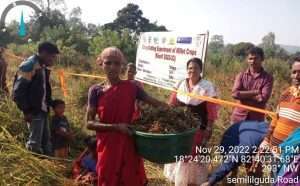 Crop cutting in a finger millet field
Crop cutting in a finger millet field
Quality Seed Production
Availability and conservation of quality seeds is highly essential for all crops. To ensure this, Pragati has adopted the strategy of providing training to farmers for quality seed production and seed selection through participatory varietal trials and seed village programmes. The staff of DoA&FW together with technical professionals are involved in providing on field support to farmers. Seventeen varieties of finger millet and seven varieties of small millets are conserved and replicated through varietal trials and in-situ conservation. Quality seeds are now preserved by individual farmers and also in the community seed banks supported by Pragati.
Encouraging Farmer Innovations
Instead of pushing a set package of practices, Pragati has been encouraging farmers’ innovations. Farmers have been motivated to try new methods, making adaptations of practices according to local conditions and based on their own assessment. For example, when the soil gets hard and it becomes difficult to use a weeder, farmers resort to manual hoeing and ploughing by bullocks, (after binding up the animals’ mouths). Pulling a wooden leveler over the plants after weeding – called ‘log rolling’ – is a farmer’s innovation that ultimately contributes to yield increase. It causes some moderate trauma in the plants leading to the growth of more roots and tillers from their crowns’ meristematic tissue. Farmers have also experimented with spacing, to know the impacts, i.e., whether more spacing will result in more tillers.
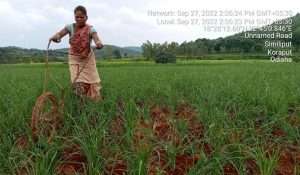 Use of weeder in SMI
Use of weeder in SMI
Promoting Weeders and Millet Threshers
Women play a major role in weeding as well as in post-harvest practices, which bring about a lot of drudgery for them. Pragati has introduced weeders and millet threshers to reduce women’s drudgery. Women can do weeding easily in less time and hence are able to manage other activities and get more time with family. Besides, men have started sharing the burden of weeding. Pragati has also introduced millet threshers among women’s groups in different millet production clusters and have trained them to operate the units. It has reduced the drudgery of women ultimately leading to increased production and consumption of millets.
- Increased Consumption of Millets – From Farm to Plate
Along with focus on enhancing production of finger millet through an improved package of practices, Pragati is also working towards increasing consumption of millets by supporting primary processing (millet threshers and cleaners), conducting nutrition awareness programmes as well as developing value-added products through women self-help groups (SHGs).
Supporting Primary Processing
Manual post-harvest de-husking of finger millet is very difficult due to its small grain size. After harvesting the farmers must dry the fingers in the sun and start threshing with the help of a stick to separate the grains. Again, they use a traditional device (Musala) to separate the outer husk from the millets, which is then ground and turned into flour. The whole process is tedious and time consuming. To reduce the drudgery and ease the post-harvest operation, Pragati has introduced millet threshers and cleaners through the women SHGs. The women are trained on operation of these units. It requires less time, reduces drudgery and has increased processing efficiency. Millet flour mills are established in different clusters through women entrepreneurs. Easing the post-harvest operations have led to increased production and consumption of millets.
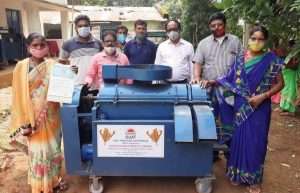 Millet Thresher
Millet Thresher
Conducting nutrition awareness programmes
Finger millet is rich in calcium, dietary fibre, phytates (0.48%), protein, minerals and phenolics. It is also a rich source of thiamine, riboflavin, iron, methionine, isoleucine, leucine, phenylalanine and other essential amino acids. The abundance of these phytochemicals enhances the nutraceutical potential of finger millet, making it a powerhouse of health-promoting nutrients. In order to create awareness on the nutritious value of millets, Pragati organizes awareness programmes through rallies with SHGs, Anganwadi workers, PRIs and school children during which millet-based foods are served to the participants. Food festivals are being organised at panchayat, block and district level for increasing awareness on nutritious value of millets and millet-based foods. Pragati has also organized a Biodiversity festival in association with ICAR-Indian Institute of Millets Research (IIMR) to create awareness on the cultivation and consumption of millets. The entrepreneurs and start ups producing and marketing millet-based foods have been a part of the programme to spread awareness among consumers on the nutritional value of millets.
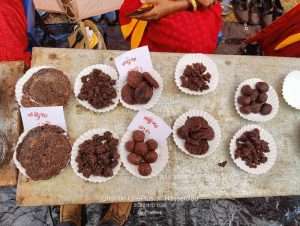 Different types of food prepared from millets
Different types of food prepared from millets
Developing and Promoting Value added Products from Millets
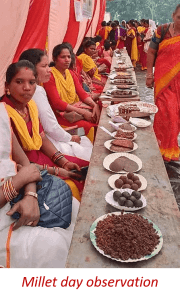 The SHG members were trained on production of value-added products and marketing these products which also contributed to increasing consumer awareness. Different millet foods prepared by women SHGs and individual entrepreneurs were displayed at food festivals at district and block level, workshops, events and exhibitions that has increased awareness among urban consumers. Brochures with recipes of millet-based foods are prepared and disseminated among consumers.
The SHG members were trained on production of value-added products and marketing these products which also contributed to increasing consumer awareness. Different millet foods prepared by women SHGs and individual entrepreneurs were displayed at food festivals at district and block level, workshops, events and exhibitions that has increased awareness among urban consumers. Brochures with recipes of millet-based foods are prepared and disseminated among consumers.
Raising Consumer Awareness
The Government of Odisha declared the first Thursday of the Hindu month of Margasira, as ‘Mandia Divas’ or ‘Millet Day’ with the objective of including nutritious and climate-friendly millet in diets, and thus move forward towards building a sustainable planet, a healthy society, as well as ensure farmers’ well-being by giving it a special place in the food system. Pragati, in association with line departments, celebrated the event in its operational area of Nandapur block under the Odisha Millet Mission. This was done through demonstration of different millet food products to spread awareness on consumption and nutritional value of millets among different levels of consumers. The Odisha Millet Mission Programme, implemented by Pragati as well as other civil society organizations, also focus on value addition and inclusion of millets in the Public Distribution System, Mid-Day Meals and Anganwadi for increasing the consumption of millets as part of wholesome diets.
- Enhancing Farmer Income through Effective Market Interventions
Supporting farmers to gain better prices
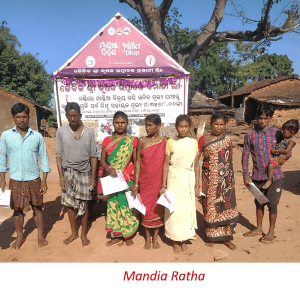 With increase in area of cultivation and yield of finger millet, farmers have started marketing surplus produce. The Minimum Support Price for Finger Millet which is significantly higher than the MSP of rice has proved to be a boon for small and marginal farmers. Farmers can sell their produce directly in the mandis arranged by the government in nearby locations which has immensely reduced the distance between farmer and market, while farmers receive payments into their accounts within a short span. The government has also created special provision for the farmers cultivating forest lands without record of rights, and also sharecroppers, to sell their surplus in mandis. Two Farmer Producer Companies established by Pragati organize mandis for procurement of finger millet. One of the strategies for generating awareness among the farmers for production, consumption and marketing of millets at MSP is the ‘Mandia Ratha’ (Box 2).
With increase in area of cultivation and yield of finger millet, farmers have started marketing surplus produce. The Minimum Support Price for Finger Millet which is significantly higher than the MSP of rice has proved to be a boon for small and marginal farmers. Farmers can sell their produce directly in the mandis arranged by the government in nearby locations which has immensely reduced the distance between farmer and market, while farmers receive payments into their accounts within a short span. The government has also created special provision for the farmers cultivating forest lands without record of rights, and also sharecroppers, to sell their surplus in mandis. Two Farmer Producer Companies established by Pragati organize mandis for procurement of finger millet. One of the strategies for generating awareness among the farmers for production, consumption and marketing of millets at MSP is the ‘Mandia Ratha’ (Box 2).
|
Box 2: Mandia Ratha As the harvesting season approaches, the Ratha moves from village to village to make the farmers aware of the registration process, quality standards, details of procurement mandis, etc. Along with procurement, the Mandia Ratha also campaigns for increasing household consumption of millets. All the campaigns and announcements are made in the local language so that farmers can easily understand. The Mandia Ratha moves through 22 Gram Panchayats of Pragati Odisha Millet Mission action areas in Nandapur block, reaching out to the most remote locations and small and marginal farmers to spread awareness on cultivation, consumption and marketing of millets at Minimum Support Price. In the last three years Pragati has supported more than 6000 farmers to market 26,000 quintals of finger millet in the mandis at Minimum Support Price (MSP). The farmers have started adopting quality standards and sell their produce after proper cleaning and grading. During 2022, Pragati has set a target to procure 33,000 quintals of finger millet through the government marketing agency which will ensure MSP to the millet farmers. |
Establishment of Farmer Producer Companies
Besides selling at Minimum Support Price, Pragati continues to support farmers in the aggregation, value addition and marketing of finger millet through the Farmer Producer Companies. Out of six Farmer Producer Companies, two FPCs established in millet production clusters help farmers in timely supply of quality seeds, organic manures, and also to market their surplus. Every year, the FPCs support around 5000 farmers in the aggregation and marketing of finger millets. One FPC has also started branding, packaging and marketing of millet food products. Pragati has also started discussions with Agricultural and Processed Food Products Export Development Authority [APEDA] established by the Government of India on export of millets.
 Millet Mandi at Koraput
Millet Mandi at Koraput
IMPACT
Area and Yield
SMI has now spread to 11,385 farmers of 236 villages covering 3847 hectares of land in Pragati’s action areas of Koraput district. The yield per hectare ranges from 23 quintals per hectare to 36 quintals per hectare, depending on varieties and type of soil. The larger, bushy root system – an outcome of following SMI methods – is a key factor in ensuring efficient uptake of water and nutrients, leading to vigorous plant growth bringing about yield increases to varying extents. The increase in yields is the significant motivating factor for farmers to adopt the practice, although initially farmers found it to be labor-intensive. Although the average yields vary according to the varieties, all varieties recorded at least 60% to 80% increase in comparison to the traditional practice.
Scaling up SMI
SMI, introduced by Pragati with the small and marginal tribal farmers for addressing food insecurity, is now incorporated in the Odisha government policy – both at national and state levels – as one of the major programs s for increasing millet production. The Odisha Millet Mission’s ‘Special Programme for Promotion of Millets in Tribal Areas of Odisha’ implemented in 19 districts of Odisha through a collaboration of civil society organizations, government and research institutes, focuses on SMI, providing incentives to the adopting farmers. Where SRI faced less ready acceptance in policy decision, SMI has been mandated by the government for promoting millet production in the state as well as at national level.
Reduction in Drudgery of Women
With use of weeders in System of Millet Intensification, women find it easier to control weeds. They feel relief that they no longer have to work the whole day in a bending position which leads to backaches, finger and toe injuries, and saves time for other activities. In some cases, men have started sharing responsibilities in weeding, because it is now mechanical rather than a hand operation, which reduces the workload of women. Harvesting becomes much easier as plant growth is more uniform, and the mature millet fingers do not get entangled. Women find it easier to harvest the fingers in an SMI field. They can complete the task in half the time as compared to the time required for harvesting a traditionally broadcasted field. The use of millet threshers has also reduced the drudgery of women in post-harvest operations.
Enhanced Income for Farmers
Adoption of SMI has enhanced income of small and marginal farmers as the production has increased manifold. In Pragati intervention areas almost 65% of farmers have started marketing their surplus. Also, the MSP fixed by government has also benefitted the millet growing farmers. The farmers earn an average profit of INR 12,000 to 15,000 per acre, besides meeting their consumption needs throughout the year.
END NOTE
On 5 March 2021 the United Nation’s General Assembly declared 2023 as the International Year of Millets (IYOM). The poor man’s food is now considered as one of the most nutritious diets, moving to urban plates. Unfortunately, it was the surge caused by the Green Revolution with its focus on rice and wheat that eroded the value of millets. Now, there has been a clarion call for their revival and perhaps this can be interlinked with some of the Sustainable Development Goals (SDG 2 – zero hunger, SDG 3 – good health and well-being, SDG 12 – sustainable consumption and production, and SDG 13 – climate action). The Government of India has decided to celebrate IYOM 2023 and make it a peoples’ movement so that Indian millets, recipes, and value-added products are accepted globally.

Promotion of millets can help meet the Sustainable Development Goals (SDG) of ending hunger and poverty in the food-insecure tribal heartlands, supplementing the income of rural households as surplus can be produced and marketed, as well as withstand the challenges of climate change aberrations. There is further need to establish primary and secondary processing centres in the vicinity of production areas so as to help producers’ get higher value.
Community-owned processing units facilitated by farmer collectives can play an instrumental role in leveraging economies of scale. Furthermore, the corporates and start-ups in the food processing industry can assist through better branding prospects with food quality/safety standards to increase consumer awareness of its nutritional benefits.
Acknowledgments
Pragati Koraput gratefully acknowledges the cooperation and the innovative efforts of the small and marginal farmers who demonstrate this technology in their respective fields. We are thankful to our donors, namely, EdelGive Foundation and the Government of Odisha under the Special Programme for Promotion of Millets in Tribal Areas of Odisha, for their consistent support in scaling up the practice among the small and marginal farmers in Koraput district.
 Dr Luna Panda, Executive Director, Pragati, Koraput, Odisha. She can be reached at (luna@pragatikoraput.org)
Dr Luna Panda, Executive Director, Pragati, Koraput, Odisha. She can be reached at (luna@pragatikoraput.org)
 Ms. Sagarika Mishra, Communication Coordinator, Pragati, Koraput, Odisha. She can be reached at (pragatikoraput@gmail.com)
Ms. Sagarika Mishra, Communication Coordinator, Pragati, Koraput, Odisha. She can be reached at (pragatikoraput@gmail.com)

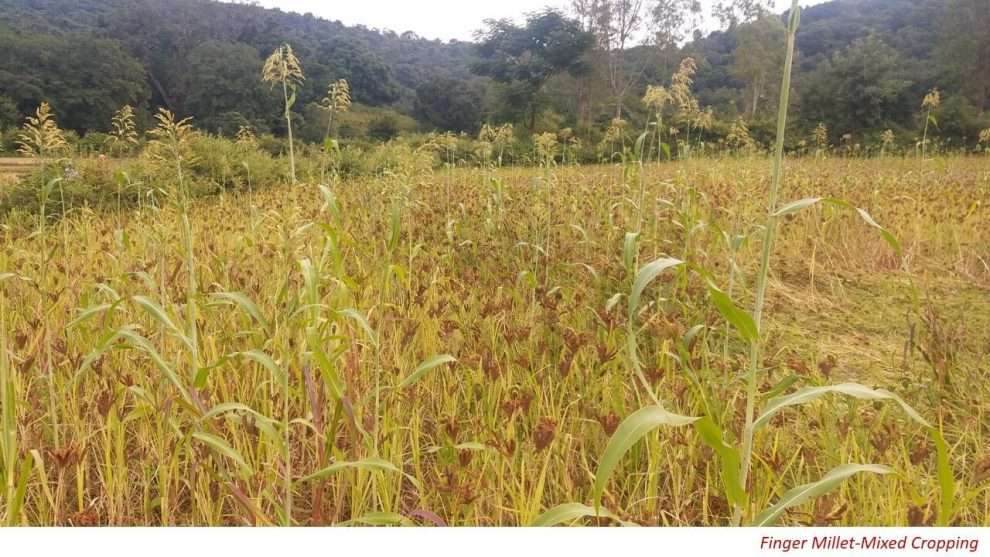

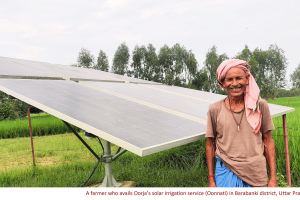
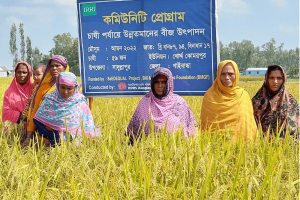
Add Comment